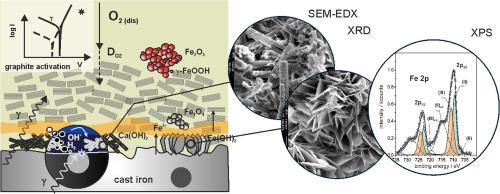Effects of γ-radiation on the interfacial chemistry of spheroidal graphite cast iron in contact with Wyoming bentonite slurry
IF 6.3
2区 材料科学
Q2 CHEMISTRY, PHYSICAL
引用次数: 0
Abstract
In most concepts for the disposal of high-level radioactive waste, cast-iron canisters containing spent fuels are encapsulated by bentonite that hydrates on contact with inflowing geological waters. This triggers the corrosion of cast iron, which can be turned worse under the exposition to significative levels of γ-radiation in unforeseeable scenarios. Such effects were examined by contrasting the chemistry of the corroded surface of spheroidal graphite cast iron in contact with Wyoming bentonite, fully hydrated with natural aerated Opalinus-Clay water, after 220 days of γ-ray exposition with a dose rate of 130 Gy h-1 at 50 °C and that observed after a similar experiment without radiation. SEM-EDX, XPS, XRD, and ICP-OES were applied. The growth of patches of calcium hydroxide and ferrous hydroxide crystals as well the presence of iron silicate layers adhered to the cast iron surface as predominant corrosion products are a fingerprint for a strong interfacial alkalization and the creation of a rather reductive milieu by radiation. These chemical transformations reveal an enhanced cathodic electrocatalytic activity of graphite nodules for water reduction under radiation which increases the anodic dissolution of the iron matrix and triggers the formation of a silicate diffusion barrier by dissolution-precipitation reactions. The radiation-induced cathodic activity may constitute an additional, more critical factor than the generation of oxygen for the container integrity, even after having reached the anoxic phase.

γ辐射对球状石墨铸铁与怀俄明州膨润土浆料接触界面化学的影响
在处理高放射性废物的大多数概念中,装有乏燃料的铸铁罐被膨润土包裹,膨润土与流入的地质水接触后会水化。这会引发铸铁的腐蚀,在不可预见的情况下,暴露在显著水平的γ辐射下会变得更糟。在50°C下130 Gy - h-1的γ射线照射220天后,通过对比与怀俄明州膨润土接触的球形石墨铸铁腐蚀表面的化学性质,以及在没有辐射的情况下进行的类似实验后的观察结果,研究了这种影响。采用SEM-EDX、XPS、XRD、ICP-OES进行表征。氢氧化钙和氢氧化铁晶体斑块的生长,以及作为主要腐蚀产物附着在铸铁表面的硅酸铁层的存在,是强界面碱化和辐射产生的相当还原环境的指纹。这些化学转变揭示了石墨结核在辐射下对水还原的阴极电催化活性增强,这增加了铁基体的阳极溶解,并通过溶解-沉淀反应触发硅酸盐扩散屏障的形成。即使在达到缺氧阶段之后,辐射诱导的阴极活性也可能构成比容器完整性产生氧气更重要的额外因素。
本文章由计算机程序翻译,如有差异,请以英文原文为准。
求助全文
约1分钟内获得全文
求助全文
来源期刊

Surfaces and Interfaces
Chemistry-General Chemistry
CiteScore
8.50
自引率
6.50%
发文量
753
审稿时长
35 days
期刊介绍:
The aim of the journal is to provide a respectful outlet for ''sound science'' papers in all research areas on surfaces and interfaces. We define sound science papers as papers that describe new and well-executed research, but that do not necessarily provide brand new insights or are merely a description of research results.
Surfaces and Interfaces publishes research papers in all fields of surface science which may not always find the right home on first submission to our Elsevier sister journals (Applied Surface, Surface and Coatings Technology, Thin Solid Films)
 求助内容:
求助内容: 应助结果提醒方式:
应助结果提醒方式:


